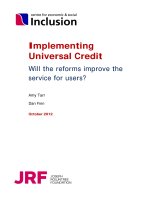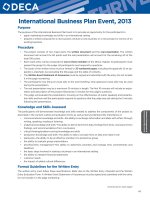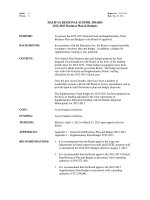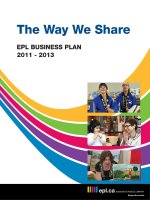EMPLOYMENT ONTARIO EMPLOYMENT SERVICE 2012-2013 BUSINESS PLAN SERVICE PROVIDER GUIDELINES ppt
Bạn đang xem bản rút gọn của tài liệu. Xem và tải ngay bản đầy đủ của tài liệu tại đây (229.93 KB, 12 trang )
EMPLOYMENT ONTARIO
EMPLOYMENT SERVICE
2012-2013 Business Plan
Service Provider Guidelines
Ministry of Training, Colleges, and Universities
2010-2012 EO Employment Service Business Plan – Service Provider Guidelines Page 2 of 12
Contents
Section 1: Introduction
a) Purpose
b) 2012-2013 ES Core Measures, Service Quality Standard (SQS) and Indicators
c) Changes Being Introduced in the 2012-2013 ES Business Plan
Corrected Service Coordination Calculation Contributing to SQS
New Continuous Improvement Requirement
Section 2: Business Plan Submission, Acceptance and Approval
d) Deadline and Required Templates
e) Business Plan Acceptance and Funding Approval Criteria
Section 3: Resources and Data Sources
Section 1: Introduction
a) Purpose
The purpose of the Employment Ontario Employment Service (ES) business planning
process is for ES service providers to plan how they will achieve the service quality
standard and continuous improvement targets, in agreement with the Ministry, within
budget, and within an annual business management cycle that ends on March 31 of
each year.
The annual business planning process enables the ongoing effective management and
success of ES service delivery by enabling service providers to understand the results
they have achieved to date at their service delivery site(s), to understand the cause of
their achieved results, to develop strategies for improvements and to adjust those
strategies on an ongoing basis.
The 2012-2013 ES Business Plan outlines the targets your organization has set
against the interim Service Quality Standard, and once completed, will inform the
responsibilities and targets in the Schedule B of your ES legal agreement. As such,
the targets identified in your Business Plan will be monitored through monthly reports
generated by the Employment Ontario Information System: Case Management
System (EOIS-CaMS), your Quarterly Status and Adjustment Report (QSAR)
submissions, as well as discussions with your Employment and Training Consultant
(ETC).
b) 2012-2013 ES Core Measures, Service Quality
Standard (SQS) and Indicators
One of the characteristics of effective performance management systems is using real
and verifiable data on actual performance to set baseline performance standards.
Performance commitments listed in the service delivery site’s (SDS’s) annual business
2012-2013 EO Employment Service Business Plan – Service Provider Guidelines Page 3 of 12
plan must meet (or exceed) the provincial service quality standard (baseline), and
commit to improvement in an organization’s actual results.
The Ministry will adjust baseline standards to reflect changes to system-wide
performance and confirm any new performance baselines for the following year as part
of the annual business planning cycle. These baseline standards will be reviewed on an
annual basis but will not necessarily be adjusted annually. Performance measure
definitions and data indicators may also change as real data becomes available for
analysis and discussion with service providers, and as our knowledge and
understanding grows.
Based on service delivery site performance during the first 20 months of ES delivery,
the Ministry has determined that there will be no changes to the ES core
measures or Service Quality Standard for 2012-2013. Please see below the
summary chart that identifies the weighting, standards and calculations contributing to
the 2012-2013 Service Quality Standard:
DIMENSION
CORE MEASURE
MINIMUM
PROVINCIAL
SERVICE
QUALITY
STANDARD
(SQS)
WEIGHT
SQS
VALUE
MAXIMUM
VALUE
1. Customer Satisfaction
(client/participant/employer)
85%
15% 1.28 1.50
Customer
Service
(40%)
2. Service Coordination 30% 25% 0.75 2.50
3. Service Impact
- Employed/Career Path
69% 25% 1.73 2.50
- Training/Education 10% 10% 0.10 1.00
Effectiveness
(50%)
4. Participant Suitability -
Participant Profile
25% 15% 0.38 1.50
5. Funded Intake and Activity
- Intake in assisted services
90% 5% 0.45 0.50
Efficiency
(10%)
- Workshop Activities /
Information Sessions
90% 5% 0.45 0.50
Service Quality Standard 5.14 10.00
The Service Quality Standard is based on a maximum value of 10. To calculate the
service quality value, each interim core measure standard is multiplied by its weight.
The SQS values are then added to result in a minimum service quality target and a
maximum service quality value. Core measures cannot achieve a value higher than
the maximum value assigned to it.
Further information about Service Quality Dimensions of Success,
Performance Core Measures, and Service Quality Targets and Standards
(including how they are derived and calculated) is available in Section 2.5 and
3.7, and Appendix 1 of the Employment Service: Service Provider Guidelines.
2012-2013 EO Employment Service Business Plan – Service Provider Guidelines Page 4 of 12
Details on how each core measure is derived can be found in the “ES Service
Quality Measures and Indicators 2010-12” document located on the Employment
Ontario Partner’s Gateway web site at:
/>nitions.pdf
c) Changes Being Introduced in the 2012-2013 ES
Business Plan
Through the 2012-2013 business planning process, the Ministry is introducing two
changes from the previous 2010-2012 business process cycle:
a clarification/correction in the calculation of the Service Coordination core
measure
the requirement that each service delivery site integrate continuous improvement
their ES delivery
Corrected Service Coordination Calculation Contributing to
SQS
Service Coordination is the measure of how the service provider’s coordination,
integration and supported access to, and from, other services are effectively
incorporated into a client’s Employment Service Plan. Service Coordination is meant to
measure the percentage of clients in the assisted Employment Service who experience
effective, supported referrals into, during, or at exit from the Employment Service.
The Ministry has recently determined that for the 2010-12 reporting period the Service
Coordination calculation used for ES performance reports was incorrect, in that the
calculation did not measure the percentage of clients accessing service coordination;
rather, the reports were calculating the ratio of indicators per client. For example:
An assisted ES client may have been formally referred in to the Employment Service
from the Ministry of Citizenship and Immigration. While receiving assisted ES services,
the client may also have been referred out to a pre-apprenticeship program (i.e.
Referred Out – Training), referred out to high school (Referred Out – Education/Training
to Complete High School), as well as being referred out to Ontario Works.
In the performance reporting calculation in place for 2010-2012, the sum total of
referred in or referred out Service Coordination indicators for assisted service plans has
been divided by the number of assisted service clients. As per the above example, the
total of four Service Coordination indicators would have been divided by the single
client, producing a Service Coordination result of 400%.
The proper calculation which will come into effect for 2012-2013 performance reporting
is for the unique number of service plans that have one or more service coordination
indicators to be divided by the total number of exits for the same reporting period. As
2012-2013 EO Employment Service Business Plan – Service Provider Guidelines Page 5 of 12
per the example above, the correct Service Coordination result would be based on one
service plan (with the four indicators), divided by the one exited service plan, producing
a Service Coordination result of 100%
Regardless of whether the assisted service participant had one or multiple service
coordination indicators they would be counted only once per closed service plan. If the
assisted client participant had multiple ES service plans within the reporting period they
could be counted multiple times but only once per ES service plan.
As a result of this error – and in order to allow service delivery sites the opportunity to
review Service Coordination performance data which is correctly calculated – the
Ministry has determined that the core measure standard for Service Coordination
for all sites in 2012-2013 will be 30%. Service Coordination will not be one of the
measures against which sites can increase their commitment level until such time as
corrected performance data has been collected through 2012-2013.
2012-2013 EO Employment Service Business Plan – Service Provider Guidelines Page 6 of 12
New Continuous Improvement Requirement
Continuous improvement provides a way to integrate the use of performance
measurement and planning for the purpose of service delivery improvement into the
fabric of an organization’s infrastructure. It does so in a clear and consistent manner
where even the best service delivery sites continue to improve.
Continuous improvement systems require that service delivery site (SDS) managers
use information to identify weaknesses and strengths. Service delivery sites must be
able to compare their performance over time, as well as how they fare against other
SDSs.
Starting with this year’s business plan submission, each site will be asked to identify
one area of strength and two areas for improvement in their service delivery, through
the annual business planning process. As the ES Performance Management System
relies upon a service provider’s ability to plan, measure, resource and communicate to
support service improvement, each site will now be required to identify which of these
organizational capacity areas have supported their site in the achievement of outcomes,
in order to better understand results and causes of their achievement.
The Ministry will require each service delivery site to identify continuous improvement
targets, depending on results to date (as of October 31, 2011) in meeting the overall
Service Quality Standard and the five core measure standards, through one of three
continuous improvement “results scenarios”:
RESULTS SCENARIO A – Meeting Interim SQT (5.14) and all
Core Measure Targets (2011-2012) as of October 31, 2011
If the site was at or above the 2011-2012 interim Service Quality Target (SQT) and was at
or above all interim core measure targets; the site must commit to:
an improved Service Quality Standard (SQS) result by improving performance on
any two of the 2012-2013 core measure standards
RESULTS SCENARIO B – Meeting Interim SQT (5.14) but not all
Core Measure Targets (2011-2012) as of October 31, 2011
If the site was at or above the 2011-2012 interim Service Quality Target (SQT) but was
not at one or more of the core measure targets; the site must commit to:
maintaining the overall Service Quality Standard, AND
an improved result on at least one of the 2012-2013 core measure standards
that is below the provincial standard AND
ensuring that any 2011-2012 core measures currently (as of October 31, 2011)
at or above standard do not fall below the provincial standard in 2012-2013
2012-2013 EO Employment Service Business Plan – Service Provider Guidelines Page 7 of 12
RESULTS SCENARIO C – Not Meeting Interim SQT (5.14) as of October 31, 2011
If the site was below the 2011-2012 interim Service Quality Target (SQT); the site must
commit to:
achieving the overall Service Quality Standard* for 2012-2013
* It is important to note that it is possible to meet the overall Service Quality Standard
without necessarily meeting the standard for each ES core measure, based on the
weightings for each core measure. In some situations, sites may exceed a core measure
standard, which raises their overall SQS value, while still have some measures which are
not at standard.
To assist SDSs in determining which results scenario should be used to support the
setting of continuous improvement targets in 2012-2013, the Ministry has included a
Reviewing Results and Developing the Plan Worksheet. Use of this worksheet is
optional by the SDS and it is does not need to be included in the business plan
submission. If SDSs do include the Worksheet as supplemental documentation in their
business plan submission, the Ministry will neither evaluate nor approve the Worksheet.
SDSs are required to identify their continuous improvement targets on Template 2:
Understanding Results and Causes and 2012-2013 Improvement Strategies.
2012-2013 EO Employment Service Business Plan – Service Provider Guidelines Page 8 of 12
Section 2: Business Plan Submission, Acceptance
and Approval
d) Deadline and Required Templates
Your service delivery site must email the three required templates to the
centralized email address for your region no later than 5:00 p.m. on Friday,
December 16, 2011. Note: Failure to submit your 2012-2013 business plan submission
by the due date may affect the date of release of funds for 2012-2013.
Please note that submission of this business plan package replaces the Q3 QSAR
reporting requirements.
The 2012-2013 ES Business Plan consists of three templates that you will be
required to complete for each service delivery site.
Template 1 – Service Delivery Site Information – allows the Ministry to
systematically and efficiently gather any changes in service provider information
(e.g. legal name, corporate and service delivery site contacts), as well as obtain
a snapshot of service delivery and service coordination considerations for the
site. Please complete a separate Service Delivery Site Information template for
each funded service delivery site.
Template 2 – Service Delivery Plan – outlines your service delivery site’s area
of strength and the two areas identified for improvement in 2012-2013 in order to
meet the ES Service Quality Standard as outlined in the “2012-2013 ES Core
Measures, Service Quality Standard and Indicators” section of this guideline and
detailed in Sections 2.5, 3.7, and Appendix 1 of the Employment Service: Service
Provider Guidelines. Please complete a separate Service Delivery Plan template
for each funded service delivery site.
The Service Delivery Plan has two areas:
1. Understanding Results and Causes: this section allows your site to
analyze progress to date in three core measure areas (one strength,
two weakness), as a way of informing your future commitments and
plans. This section enables your site to identify/attribute a causal
relationship between your service delivery strategies and
organizational capacity in order to achieve results, in the areas of
planning, measuring, resourcing and communicating, as outlined in
Section 2.4 of the Employment Service: Service Provider Guidelines.
While this section of the template is not subject to Ministry evaluation
or approval, it does provide information that helps us understand the
rationale behind the proposed targets in the 2012-2013 Improvement
Strategies section.
2012-2013 EO Employment Service Business Plan – Service Provider Guidelines Page 9 of 12
2. 2012-2013 Improvement Strategies: in this section your site will
identify the one strength on which you plan to build, and two areas that
your organization plans to develop and focus on in 2012-2013. Within
each of these areas, your site will identify in-year target milestones
against which you may measure your progress and evaluate the
strategies and actions you are taking to meet your development goals.
Your Q4 milestone will be the commitment which is included in the
Schedule B of your legal agreement with the Ministry. Throughout the
2012-13, fiscal year, your site will be required to review, analyze and
report your progress against these quarterly milestones, commitments
and strategies in your Quarterly Status and Adjustment Report (QSAR)
submissions.
Template 3 – Schedule B Commitments – identifies the targets that your site is
making against each of the core measure standards, including the Funded
Activity and Intake measures, and the overall Service Quality Standard. Please
complete a separate Schedule B Commitments template for each funded service
delivery site.
Please see the Submission Instructions at the top of page 1 of the fillable PDF
file, “ES Business Plan Templates”, for detailed instructions on electronically
submitting your business plan.
e) Business Plan Acceptance and Funding Approval
Criteria
This section clarifies which components of the Business Plan Submission Package are
approved by MTCU, and the criteria and standards for approval.
Ministry Responsibilities:
The Business Plan submission will be accepted for review when all required data is
completed and emailed to the Ministry by the submission deadline.
In making decisions about continued funding and agreement renewals, the Ministry
uses the ES Funding Decision Matrix, as outlined in section 2.6 of the ES Service
Provider Guidelines. Four main criteria affect Ministry decisions:
compliance with the Ministry’s legal agreement and service guidelines, as
evidenced through the Ministry’s monitoring activities;
achievement of the provincial Service Quality Standard;
evidence of organizational capacity; and,
achievement of continuous improvement targets
While the continuous improvement targets your service delivery site submits through
Template 2 provides the Ministry with context for the decisions and commitments your
site has made for your legal agreement, these sections of the Business Plan are not
2012-2013 EO Employment Service Business Plan – Service Provider Guidelines Page 10 of 12
subject to evaluation or approval by Ministry. In other words, the Ministry does not
approve the targets which you had identified; however, it is important to note that MTCU
will not approve continued funding for your site unless a commitment to the
achievement of the Service Quality Standard, as well as continuous improvement
targets, are articulated in your 2012-2013 ES business plan.
In order for the Ministry to approve funding for your service delivery site in 2012-
2013, your Schedule B Commitments must:
demonstrate continuous improvement
achieve the provincial Service Quality Standard
As was the case with the 2010-2012 ES agreement, the Ministry will provide your site
with a notional budget allocation in the following funding categories to support your
site’s business planning process:
Operating Funds
Placement Incentives for Employers
Employment and Training Supports for Individuals
In future annual business planning cycles, the funding your site receives within the
ES service unit intake ranges – and as a result, your site’s corresponding operating
funding allocation – may be linked to a number of variables, which, along with your
performance commitments, will inform the funding decision. Variables include:
Client base
Location
Labour market environment
Results
Economies of scale
The Ministry is responsible for the determination of the level of service (i.e. service
unit allocations) which may be required in each community, according to the
Ministry’s community service plan for ES delivery. For 2012-2013 service unit
allocations will remain the same; however, in future years the Ministry may begin to
make adjustments, as further information regarding the need for ES in communities is
collected and reported through EOIS-CaMS.
The Ministry and your organization will work together to address the employment
needs of the community and to ensure continuous improvement of ES by reviewing
results against your site’s business plan commitments.
Service Provider Responsibilities:
The business plan addresses your organization’s commitment to service levels at
your service delivery site, as well as your site’s achievement of the Service Quality
Standard and continuous improvement targets, within budget.
2012-2013 EO Employment Service Business Plan – Service Provider Guidelines Page 11 of 12
Your organization will be held accountable for the outcomes your have submitted on
Template 3: Schedule B Commitments as part of the Employment Service
Performance Management System (Section 2.4 of the Employment Service: Service
Provider Guidelines). Your organization is responsible for the service delivery plan
through which you will achieve those targets and outcomes.
The Ministry is committed to supporting your organization in developing your plans.
2012-2013 EO Employment Service Business Plan – Service Provider Guidelines Page 12 of 12
Section 3: Resources and Data Sources
A number of resources and data sources are available to support the development of
your site’s 2012-2013 ES business plan, including:
Employment Service – Service Provider Guidelines
ES Service Quality Measures and Indicators 2010-12, located on the EOPG at:
/>ndicators_definitions.pdf
Performance reports available via the EOIS-CaMS external reporting portal:
2011-2012 October ES Detailed Service Quality (#11) or ES Service
Quality (#10) reports and other associated reports
2010-2011 March (year-end) and 2011-2012 ES Detailed Service Quality
(#11) or ES Service Quality (#10) reports and other associated reports









